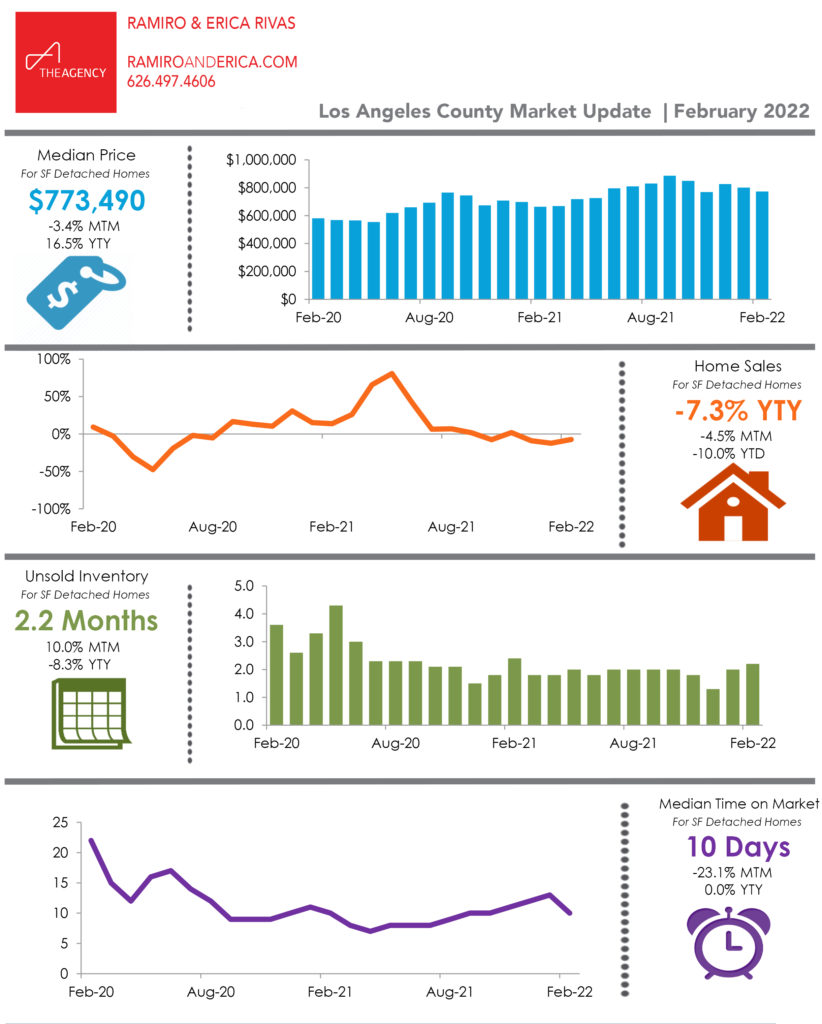

- In February, existing-home sales fell to a seasonally adjusted annual rate of 6.02 million. Sales were down 7.2% from the prior month and 2.4% from one year ago.
- The inventory of unsold existing homes slightly increased to 870,000 as of the end of February, equivalent to 1.7 months of supply at the current monthly sales pace.
- The median existing-home sales price rose to $357,300, up 15.0% from one year ago. This marks 120 consecutive months of year-over-year price increases, the longest-running streak on record.
WASHINGTON (March 18, 2022) – Existing-home sales dipped in February, continuing a seesawing pattern of gains and declines over the last few months, according to the National Association of Realtors®. Each of the four major U.S. regions saw sales fall on a month-over-month basis in February. Sales activity year-over-year was also down overall, though the South experienced an increase while the remaining three regions reported drops in transactions.

Total existing-home sales,1 https://www.nar.realtor/existing-home-sales, completed transactions that include single-family homes, townhomes, condominiums and co-ops, sank 7.2% from January to a seasonally adjusted annual rate of 6.02 million in February. Year-over-year, sales decreased 2.4% (6.17 million in February 2021).
“Housing affordability continues to be a major challenge, as buyers are getting a double whammy: rising mortgage rates and sustained price increases,” said Lawrence Yun, NAR’s chief economist. “Some who had previously qualified at a 3% mortgage rate are no longer able to buy at the 4% rate.
“Monthly payments have risen by 28% from one year ago – which interestingly is not a part of the consumer price index – and the market remains swift with multiple offers still being recorded on most properties.”
Total housing inventory2 at the end of February totaled 870,000 units, up 2.4% from January and down 15.5% from one year ago (1.03 million). Unsold inventory sits at a 1.7-month supply at the current sales pace, up from the record-low supply in January of 1.6 months and down from 2.0 months in February 2021.
Yun notes that rising rates and escalating prices have prevented many consumers from making a purchase.
“The sharp jump in mortgage rates and increasing inflation is taking a heavy toll on consumers’ savings,” he said. “However, I expect the pace of price appreciation to slow as demand cools and as supply improves somewhat due to more home construction.”
The median existing-home price3 for all housing types in February was $357,300, up 15.0% from February 2021 ($310,600), as prices grew in each region. This marks 120 consecutive months of year-over-year increases, the longest-running streak on record.
Properties typically remained on the market for 18 days in February, down from 19 days in January and 20 days in February 2021. Eighty-four percent of homes sold in February 2022 were on the market for less than a month.
First-time buyers were responsible for 29% of sales in February, up from 27% in January and down from 31% in February 2021. NAR’s 2021 Profile of Home Buyers and Sellers – released in late 20214 – reported that the annual share of first-time buyers was 34%.
Individual investors or second-home buyers, who make up many cash sales, purchased 19% of homes in February, down from 22% in January but up from 17% in February 2021. All-cash sales accounted for 25% of transactions in February, down from 27% in January and up from 22% in February 2021.
Distressed sales5 – foreclosures and short sales – represented less than 1% of sales in February, equal to the percentage seen in both January 2022 and February 2021.
According to Freddie Mac, the average commitment rate(link is external) for a 30-year, conventional, fixed-rate mortgage was 3.76% in February, up from 3.45% in January. The average commitment rate across all of 2021 was 2.96%.
Realtor.com®’s Market Trends Report(link is external) in February shows that the greatest year-over-year median list price growth occurred in Las Vegas (+39.6%), Miami (+31.6%) and Tampa (+31.5%). Austin posted the highest growth in the share of homes which had their prices reduced compared to last year (+3.3 percentage points), followed by Milwaukee (+2.1 percentage points), Pittsburgh and Baltimore (+1.4 percentage points each).
Single-family and Condo/Co-op Sales
Single-family home sales dropped to a seasonally adjusted annual rate of 5.35 million in February, down 7.0% from 5.75 million in January and down 2.2% from one year ago. The median existing single-family home price was $363,800 in February, up 15.5% from February 2021.
Existing condominium and co-op sales were recorded at a seasonally adjusted annual rate of 670,000 units in February, down 9.5% from 740,000 in January and down 4.3% from one year ago. The median existing condo price was $305,400 in February, an annual increase of 10.9%.
“For the past couple of years, buyers have had to contend with a market of high demand, low inventory and a mix of uncertainties with COVID-19 protocols,” said NAR President Leslie Rouda Smith, a Realtor® from Plano, Texas, and a broker associate at Dave Perry-Miller Real Estate in Dallas. “Consumers are presently challenged with higher mortgage rates, so now, more than ever, interested buyers need the trusted expertise of Realtors® in order to navigate this current market.”
Regional Breakdown
Existing-home sales in the Northeast slipped 11.5% in February, registering an annual rate of 690,000, a 12.7% drop from February 2021. The median price in the Northeast was $383,700, up 7.1% from one year ago.
Existing-home sales in the Midwest sagged 11.3% from the prior month to an annual rate of 1,330,000 in February, a 1.5% decrease from February 2021. The median price in the Midwest was $248,900, a 7.5% climb from February 2021.
Existing-home sales in the South fell 5.1% in February from the prior month, posting an annual rate of 2,790,000, an increase of 3.0% from one year ago. The median price in the South was $318,800, an 18.1% jump from one year prior. For the sixth straight month, the South experienced the highest pace of price appreciation compared to the other regions.
“Employment is vital for housing demand,” said Yun. “The Southern states are seeing faster job growth, and consequently, it’s the only region to experience a sales gain from a year ago.”
Existing-home sales in the West slid 4.7% from the previous month, reporting an annual rate of 1,210,000 in February, down 8.3% from one year ago. The median price in the West was $512,600, up 7.1% from February 2021.
The National Association of Realtors® is America’s largest trade association, representing more than 1.5 million members involved in all aspects of the residential and commercial real estate industries.
# # #
For local information, please contact the local association of Realtors® for data from local multiple listing services (MLS). Local MLS data is the most accurate source of sales and price information in specific areas, although there may be differences in reporting methodology.
NOTE: NAR’s Pending Home Sales Index for February is scheduled for release on March 25, and Existing-Home Sales for March will be released on April 20; release times are 10:00 a.m. ET.
1 Existing-home sales, which include single-family, townhomes, condominiums and co-ops, are based on transaction closings from Multiple Listing Services. Changes in sales trends outside of MLSs are not captured in the monthly series. NAR benchmarks home sales periodically using other sources to assess overall home sales trends, including sales not reported by MLSs.
Existing-home sales, based on closings, differ from the U.S. Census Bureau’s series on new single-family home sales, which are based on contracts or the acceptance of a deposit. Because of these differences, it is not uncommon for each series to move in different directions in the same month. In addition, existing-home sales, which account for more than 90% of total home sales, are based on a much larger data sample – about 40% of multiple listing service data each month – and typically are not subject to large prior-month revisions.
The annual rate for a particular month represents what the total number of actual sales for a year would be if the relative pace for that month were maintained for 12 consecutive months. Seasonally adjusted annual rates are used in reporting monthly data to factor out seasonal variations in resale activity. For example, home sales volume is normally higher in the summer than in the winter, primarily because of differences in the weather and family buying patterns. However, seasonal factors cannot compensate for abnormal weather patterns.
Single-family data collection began monthly in 1968, while condo data collection began quarterly in 1981; the series were combined in 1999 when monthly collection of condo data began. Prior to this period, single-family homes accounted for more than nine out of 10 purchases. Historic comparisons for total home sales prior to 1999 are based on monthly single-family sales, combined with the corresponding quarterly sales rate for condos.
2 Total inventory and month’s supply data are available back through 1999, while single-family inventory and month’s supply are available back to 1982 (prior to 1999, single-family sales accounted for more than 90% of transactions and condos were measured only on a quarterly basis).
3 The median price is where half sold for more and half sold for less; medians are more typical of market conditions than average prices, which are skewed higher by a relatively small share of upper-end transactions. The only valid comparisons for median prices are with the same period a year earlier due to seasonality in buying patterns. Month-to-month comparisons do not compensate for seasonal changes, especially for the timing of family buying patterns. Changes in the composition of sales can distort median price data. Year-ago median and mean prices sometimes are revised in an automated process if additional data is received.
The national median condo/co-op price often is higher than the median single-family home price because condos are concentrated in higher-cost housing markets. However, in a given area, single-family homes typically sell for more than condos as seen in NAR’s quarterly metro area price reports.
4 Survey results represent owner-occupants and differ from separately reported monthly findings from NAR’s Realtors® Confidence Index, which include all types of buyers. Investors are under-represented in the annual study because survey questionnaires are mailed to the addresses of the property purchased and generally are not returned by absentee owners. Results include both new and existing homes.
5 Distressed sales (foreclosures and short sales), days on market, first-time buyers, all-cash transactions and investors are from a monthly survey for the NAR’s Realtors® Confidence Index, posted at nar.realtor.
